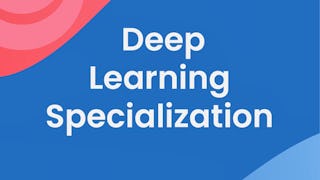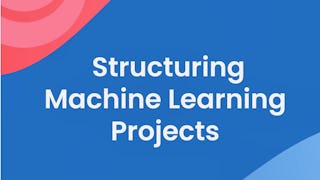Ihr Smartphone, Ihre Smartwatch und Ihr Auto (wenn es sich um ein neueres Modell handelt) verfügen über KI (Künstliche Intelligenz), die Ihnen jeden Tag hilft. In naher Zukunft werden fortschrittlichere, "selbstlernende" DL- (Deep Learning) und ML- (Machine Learning) Technologien in fast jedem Aspekt Ihres Unternehmens und Ihrer Branche zum Einsatz kommen. Jetzt ist also der richtige Zeitpunkt, um zu lernen, was DL und ML sind und wie Sie sie zum Vorteil Ihres Unternehmens einsetzen können. Dieser Kurs besteht aus drei Teilen, wobei sich der erste Teil auf die auf DL- und ML-Technologien basierende zukünftige Geschäftsstrategie konzentriert, einschließlich Details zu neuen hochmodernen Produkten/Dienstleistungen und Open Source DL-Software, die die Zukunft ermöglichen. Der zweite Teil konzentriert sich auf die Kerntechnologien von DL- und ML-Systemen, zu denen NN- (Neuronales Netzwerk), CNN- (Convolutional NN) und RNN- (Recurrent NN) Systeme gehören. Der dritte Teil konzentriert sich auf vier TensorFlow Playground-Projekte, in denen Sie mit Hilfe einer einfachen und unterhaltsamen, aber sehr leistungsfähigen Anwendung namens TensorFlow Playground Erfahrungen mit dem Entwurf von DL-NNs sammeln können. Dieser Kurs wurde entwickelt, um Sie bei der Entwicklung von Geschäftsstrategien zu unterstützen und Sie in die Lage zu versetzen, technische Planungen für neue DL- und ML-Dienste und -Produkte durchzuführen.



(678 Bewertungen)
Kompetenzen, die Sie erwerben
- Kategorie: Künstliche neuronale Netze
- Kategorie: Deep Learning
- Kategorie: Human Learning
- Kategorie: Maschinelles Lernen
- Kategorie: Angewandtes maschinelles Lernen
- Kategorie: Algorithmen für maschinelles Lernen
- Kategorie: Algorithmen
Wichtige Details

Zu Ihrem LinkedIn-Profil hinzufügen
10 Aufgaben
Erfahren Sie, wie Mitarbeiter führender Unternehmen gefragte Kompetenzen erwerben.


Erwerben Sie ein Karrierezertifikat.
Fügen Sie diese Qualifikation zur Ihrem LinkedIn-Profil oder Ihrem Lebenslauf hinzu.
Teilen Sie es in den sozialen Medien und in Ihrer Leistungsbeurteilung.

In diesem Kurs gibt es 6 Module
Für den Kurs "Deep Learning for Business" ist das erste Modul "Deep Learning Products & Services". Es beginnt mit der Vorlesung "Future Industry Evolution & Artificial Intelligence", in der vergangene, aktuelle und zukünftige Entwicklungen in der Industrie erläutert werden und wie DL- (Deep Learning) und ML- (Machine Learning) Technologie in naher Zukunft in fast jedem Aspekt der Industrie eingesetzt werden wird. Die folgenden Vorträge befassen sich mit den heißesten DL- und ML-Produkten und -Dienstleistungen, die die Geschäftswelt begeistern. Zunächst wird der "Jeopardy!"-Gewinner und vielseitige IBM Watson mit seinen DeepQA- und AdaptWatson-Systemen, die DL-Technologie nutzen, vorgestellt. Dann werden die Produkte Amazon Echo und Echo Dot sowie der cloudbasierte persönliche Assistent Alexa vorgestellt, der ASR- (Automated Speech Recognition) und NLU-Technologie (Natural Language Understanding) verwendet. Der nächste Vortrag befasst sich mit LettuceBot, einem DL-System, das Salatsamen mit automatischer Düngemittel- und Herbiziddüsenkontrolle anpflanzt. Dann wird das auf Computer Vision basierende DL-Diagnosesystem Athelas zur Analyse von Blutzellen vorgestellt, gefolgt von der Einführung eines DL-Systems zur Komposition klassischer und symphonischer Musik namens AIVA (Artificial Intelligence Virtual Artist). Als letztes Thema von Modul 1 werden das kommende Apple watchOS 4 und der HomePod-Lautsprecher vorgestellt, die auf der WWDC 2017 (World Wide Developers Conference) von Apple präsentiert wurden.
Das ist alles enthalten
5 Videos2 Aufgaben
Das zweite Modul "Business with Deep Learning & Machine Learning" konzentriert sich zunächst in der Vorlesung "Business Considerations in the Machine Learning Era" auf verschiedene geschäftliche Überlegungen, die auf den Veränderungen beruhen, die durch die DL- (Deep Learning) und ML- (Machine Learning) Technologie zu erwarten sind In der folgenden Vorlesung "Business Strategy with Machine Learning & Deep Learning" werden die Veränderungen erläutert, die notwendig sind, um in der Wirtschaft erfolgreicher zu sein, und es wird ein Beispiel für die Modellierung einer Geschäftsstrategie anhand der drei Phasen Vorbereitung, Geschäftsmodellierung und Modellüberprüfung und -anpassung gegeben. Der nächste Vortrag "Warum ist Deep Learning jetzt so populär?" erklärt die Veränderungen in den jüngsten Technologien und Unterstützungssystemen, die es den DL-Systemen ermöglichen, mit erstaunlicher Geschwindigkeit, Genauigkeit und Zuverlässigkeit zu arbeiten. Der letzte Vortrag "Merkmale von Unternehmen mit DL & ML" erklärt zunächst die Merkmale von DL- und ML-basierten Unternehmen auf der Grundlage von Datentypen, gefolgt von DL- & ML-Einsatzoptionen, der Wettbewerbslandschaft und zukünftigen Möglichkeiten.
Das ist alles enthalten
4 Videos2 Aufgaben1 Diskussionsthema
Das dritte Modul "Deep Learning Computing Systems & Software" konzentriert sich auf die wichtigsten DL (Deep Learning) und ML (Machine Learning) Systeme und Software. Mit Ausnahme des NVIDIA DGX-1 sind die in diesem Modul vorgestellten DL-Systeme und Software unverkäuflich und scheinen daher auf den ersten Blick für Unternehmen nicht wichtig zu sein. Aber in Wirklichkeit sind die Unternehmen, die diese Systeme und Software entwickelt haben, die wahren Führer der zukünftigen DL- und ML-Geschäftsära. Daher führt dieses Modul in den wahren Stand der DL- und ML-Technologie ein. In der ersten Vorlesung werden die populärsten DL-Open-Source-Programme TensorFlow, CNTK (Cognitive Toolkit), Keras, Caffe und Theano und ihre Eigenschaften vorgestellt. Aufgrund ihrer Popularität, ihres starken Einflusses und ihrer vielfältigen Fähigkeiten werden in den folgenden Vorträgen die Details von Google TensorFlow und Microsoft CNTK vorgestellt. Als Nächstes wird der Supercomputer DGX-1 von NVIDIA vorgestellt, der über eine vollständig integrierte, maßgeschneiderte DL-Hardware und -Software verfügt. In den folgenden Vorträgen wird der interessanteste Wettbewerb zwischen Mensch und Maschine in der Google AlphaGo Vorlesung vorgestellt und in der ILSVRC (ImageNet Large Scale Visual Recognition Challenge) Vorlesung werden die Ergebnisse des Wettbewerbs zwischen hochmodernen DL-Systemen vorgestellt und die Siegerleistung für jedes Jahr verglichen.
Das ist alles enthalten
4 Videos2 Aufgaben
Das Modul "Grundlagen von Deep Learning Neural Networks" konzentriert sich zunächst auf die Erläuterung der technischen Unterschiede von AI (Künstliche Intelligenz), ML (Maschinelles Lernen) und DL (Deep Learning) in der ersten Vorlesung mit dem Titel "Was ist DL (Deep Learning) und ML (Maschinelles Lernen)" Darüber hinaus werden die Merkmale der bei DL verwendeten CPUs (Central Processing Units) und GPUs (Graphics Processing Units) sowie die repräsentativen Computerleistungseinheiten FLOPS (FLoating-Point Operations Per Second) und IPS (Instructions Per Second) vorgestellt. Als nächstes wird in der NN (Neuronales Netzwerk) Vorlesung das biologische Neuron (Nervenzelle) und seine Signalübertragung vorgestellt, gefolgt von einem ANN (Künstliches Neuronales Netzwerk) Modell eines Neurons, das auf einer Schwellenlogikeinheit und weichen Ausgangsaktivierungsfunktionen basiert. Dann werden die erweiterten NN-Technologien, die MLP (Multi-Layer Perceptron), SoftMax und AutoEncoder verwenden, erläutert. In der letzten Vorlesung des Moduls wird das NN-Lernen auf der Grundlage von Backpropagation zusammen mit den Lernmethoden vorgestellt, zu denen überwachtes Lernen, unbeaufsichtigtes Lernen, halbüberwachtes Lernen und verstärkendes Lernen gehören.
Das ist alles enthalten
3 Videos2 Aufgaben
Das Modul "Deep Learning mit CNN & RNN" konzentriert sich auf die CNN (Convolutional Neural Network) und RNN (Recurrent Neural Network) Technologie, die DL (Deep Learning) ermöglicht. Zunächst wird erläutert, wie CNNs, die in der Bild-/Videoerkennung, in Empfehlungssystemen, in der Verarbeitung natürlicher Sprache und in Spielen (wie Schach und Go) eingesetzt werden, durch die Verarbeitung in der Faltungsschicht und in Feature Maps ermöglicht werden. Der Vortrag stellt auch vor, wie CNNs Subsampling (Pooling), LCN (Local Contrast Normalization), Dropout, Ensemble und Bagging-Technologie verwenden, um effizienter, zuverlässiger, robuster und genauer zu werden. Als nächstes wird vorgestellt, wie DL mit RNN in der Spracherkennung (wie in Apples Siri, Googles Voice Search und Samsungs S Voice), der Handschrifterkennung, der Sequenzdatenanalyse und der Programmcodegenerierung eingesetzt wird. Dann werden die Details der RNN-Technologien vorgestellt, darunter S2S (Sequence to Sequence) Lernen, Forward RNN, Backward RNN, Repräsentationstechniken, kontextbasierte Projektion und Repräsentation mit Aufmerksamkeit. Im letzten Teil des Moduls werden das frühe Modell von RNN, das FRNN (Fully Recurrent NN), und das derzeit beliebte RNN-Modell LSTM (Long Short-Term Memory) vorgestellt.
Das ist alles enthalten
2 Videos2 Aufgaben1 Diskussionsthema
Das Modul "Deep Learning Project with TensorFlow Playground" konzentriert sich auf vier NN (Neural Network) Design-Projekte, bei denen Sie mit Hilfe einer unterhaltsamen und leistungsstarken Anwendung namens TensorFlow Playground Erfahrungen mit dem Design von DL (Deep Learning) NNs sammeln können. In den Vorlesungen lernen Sie zunächst, wie Sie den TensorFlow Playground verwenden. Anschließend erhalten Sie eine Anleitung für drei Projekte, mit denen Sie auf einfache Weise Erfahrung mit dem TensorFlow Playground System sammeln können. In Projekt 4 wird dann eine "DL NN Design Challenge" gegeben, bei der Sie das NN "Tiefer" machen müssen, indem Sie versteckte Schichten und Neuronen hinzufügen, um die Klassifizierungsziele zu erfüllen. Das Wissen, das Sie in den Vorlesungen der Module 1~5 erworben haben, wird in diesen Projekten verwendet.
Das ist alles enthalten
3 Videos1 Diskussionsthema
Dozent

Empfohlen, wenn Sie sich für Geschäftsstrategie interessieren


DeepLearning.AI


DeepLearning.AI
Warum entscheiden sich Menschen für Coursera für ihre Karriere?




Bewertungen von Lernenden
678 Bewertungen
- 5 stars
61,79 %
- 4 stars
26,10 %
- 3 stars
6,93 %
- 2 stars
3,24 %
- 1 star
1,91 %
Zeigt 3 von 678 an
Geprüft am 13. Nov. 2021
Great pace and information. There is no giveaways. You really have to pay attention to the topic and take notes. Otherwise, the quizzes will kick your ass.
Geprüft am 13. Feb. 2020
Great course, especially for the people who are implementing NN's into their business models to investigate inefficiencies and automate human tasks as much as possible.
Geprüft am 20. Jan. 2020
This course is great, easy understanding and full of knowledge, I'll definitely recommend it to my friends

Neue Karrieremöglichkeiten mit Coursera Plus
Unbegrenzter Zugang zu 10,000+ Weltklasse-Kursen, praktischen Projekten und berufsqualifizierenden Zertifikatsprogrammen - alles in Ihrem Abonnement enthalten
Bringen Sie Ihre Karriere mit einem Online-Abschluss voran.
Erwerben Sie einen Abschluss von erstklassigen Universitäten – 100 % online
Schließen Sie sich mehr als 3.400 Unternehmen in aller Welt an, die sich für Coursera for Business entschieden haben.
Schulen Sie Ihre Mitarbeiter*innen, um sich in der digitalen Wirtschaft zu behaupten.
Häufig gestellte Fragen
Der Zugang zu Vorlesungen und Aufgaben hängt von der Art Ihrer Einschreibung ab. Wenn Sie einen Kurs im Prüfungsmodus belegen, können Sie die meisten Kursmaterialien kostenlos einsehen. Um auf benotete Aufgaben zuzugreifen und ein Zertifikat zu erwerben, müssen Sie die Zertifikatserfahrung während oder nach Ihrer Prüfung erwerben. Wenn Sie die Prüfungsoption nicht sehen:
Der Kurs bietet möglicherweise keine Prüfungsoption. Sie können stattdessen eine kostenlose Testversion ausprobieren oder finanzielle Unterstützung beantragen.
Der Kurs bietet möglicherweise stattdessen die Option 'Vollständiger Kurs, kein Zertifikat'. Mit dieser Option können Sie alle Kursmaterialien einsehen, die erforderlichen Bewertungen abgeben und eine Abschlussnote erhalten. Dies bedeutet auch, dass Sie kein Zertifikat erwerben können.
Wenn Sie ein Zertifikat erwerben, erhalten Sie Zugang zu allen Kursmaterialien, einschließlich der benoteten Aufgaben. Nach Abschluss des Kurses wird Ihr elektronisches Zertifikat zu Ihrer Erfolgsseite hinzugefügt - von dort aus können Sie Ihr Zertifikat ausdrucken oder zu Ihrem LinkedIn-Profil hinzufügen. Wenn Sie die Kursinhalte nur lesen und ansehen möchten, können Sie den Kurs kostenlos besuchen.
Sie haben Anspruch auf eine vollständige Rückerstattung bis zwei Wochen nach Ihrem Zahlungsdatum oder (bei Kursen, die gerade erst begonnen haben) bis zwei Wochen nach Beginn der ersten Sitzung des Kurses, je nachdem, welcher Zeitpunkt später liegt. Sie können keine Rückerstattung erhalten, sobald Sie ein Kurszertifikat erworben haben, auch wenn Sie den Kurs innerhalb der zweiwöchigen Rückerstattungsfrist abschließen. Siehe unsere vollständigen Rückerstattungsbedingungen.
Weitere Fragen
Finanzielle Unterstützung verfügbar,
 enthalten
enthalten



